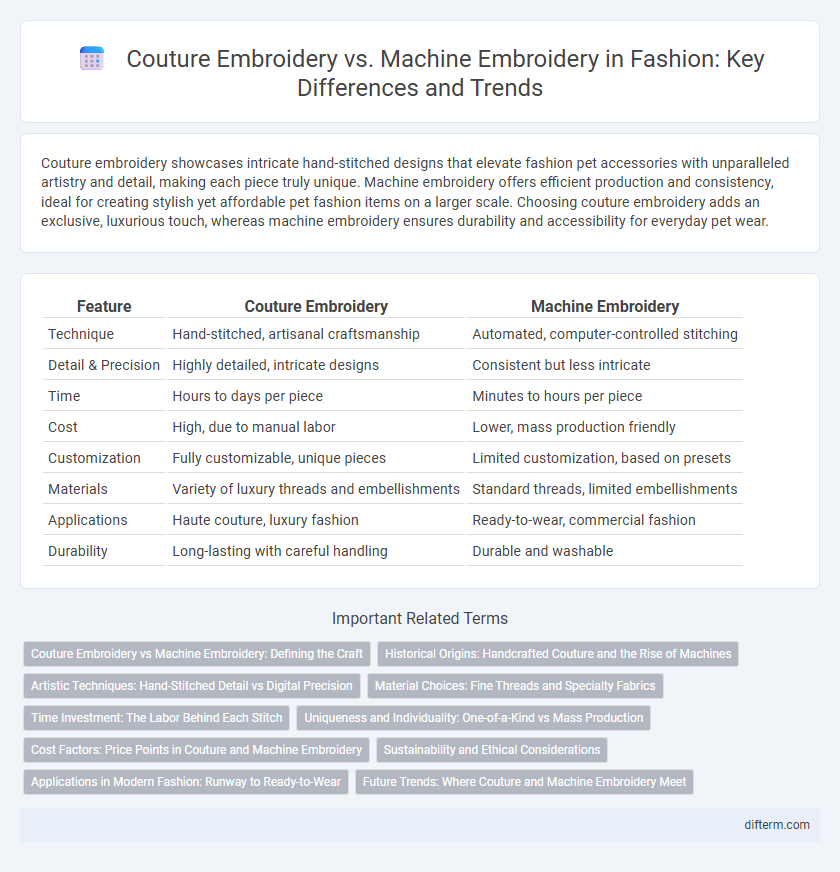Couture embroidery showcases intricate hand-stitched designs that elevate fashion pet accessories with unparalleled artistry and detail, making each piece truly unique. Machine embroidery offers efficient production and consistency, ideal for creating stylish yet affordable pet fashion items on a larger scale. Choosing couture embroidery adds an exclusive, luxurious touch, whereas machine embroidery ensures durability and accessibility for everyday pet wear.
Table of Comparison
| Feature | Couture Embroidery | Machine Embroidery |
|---|---|---|
| Technique | Hand-stitched, artisanal craftsmanship | Automated, computer-controlled stitching |
| Detail & Precision | Highly detailed, intricate designs | Consistent but less intricate |
| Time | Hours to days per piece | Minutes to hours per piece |
| Cost | High, due to manual labor | Lower, mass production friendly |
| Customization | Fully customizable, unique pieces | Limited customization, based on presets |
| Materials | Variety of luxury threads and embellishments | Standard threads, limited embellishments |
| Applications | Haute couture, luxury fashion | Ready-to-wear, commercial fashion |
| Durability | Long-lasting with careful handling | Durable and washable |
Couture Embroidery vs Machine Embroidery: Defining the Craft
Couture embroidery involves meticulous hand-stitching techniques that create intricate, unique designs, emphasizing craftsmanship and artistry, whereas machine embroidery offers faster production with consistent patterns but lacks the personalized detail of couture work. Hand embroidery uses fine needles, varied stitches, and often incorporates beads, sequins, and delicate threads to achieve a textured, multidimensional effect exclusive to luxury fashion. Machine embroidery relies on programmed designs stitched by computerized machines, suitable for mass production but unable to replicate the nuanced textures and bespoke quality of couture pieces.
Historical Origins: Handcrafted Couture and the Rise of Machines
Couture embroidery originated in the meticulous hand-stitched embellishments crafted by skilled artisans during the 19th century, embodying luxury and exclusivity in haute couture fashion. Machine embroidery emerged in the early 20th century, revolutionizing production by enabling faster and more consistent designs while making intricate patterns accessible for mass-market apparel. The historical evolution from handcrafted couture embroidery to mechanized techniques reflects a shift in fashion from bespoke artistry to scalable innovation.
Artistic Techniques: Hand-Stitched Detail vs Digital Precision
Couture embroidery showcases intricate hand-stitched details that bring unparalleled artistry and unique texture to each garment, reflecting the artisan's skill and creativity. Machine embroidery delivers precise, consistent patterns achieved through advanced digital programming, allowing for high efficiency and repeatability in design replication. The contrast between the organic, tactile quality of hand embroidery and the streamlined accuracy of machine embroidery highlights the distinctive artistic techniques influencing fashion craftsmanship.
Material Choices: Fine Threads and Specialty Fabrics
Couture embroidery utilizes fine threads such as silk, metallic, and hand-dyed floss, enhancing luxury fabrics like chiffon, silk organza, and velvet for exquisite texture and depth. Machine embroidery often employs polyester or rayon threads, optimized for durability and consistency on robust materials like cotton blends and denim. Selecting specialty fabrics and thread types significantly impacts the precision, richness, and overall aesthetic of embroidered fashion designs.
Time Investment: The Labor Behind Each Stitch
Couture embroidery demands extensive hours of meticulous handwork by skilled artisans, often taking days to complete intricate patterns, reflecting unparalleled craftsmanship. Machine embroidery significantly reduces production time using automated technology, enabling faster turnaround but with less detailed customization. The time investment in couture embroidery results in unique, high-value pieces, while machine embroidery suits mass production and consistency.
Uniqueness and Individuality: One-of-a-Kind vs Mass Production
Couture embroidery offers unparalleled uniqueness, with each stitch handcrafted to create one-of-a-kind designs that reflect individual artistry and meticulous detail. Machine embroidery, while efficient for mass production, often results in uniform patterns lacking the personal touch and exclusivity found in couture pieces. The distinctiveness of couture embroidery ensures garments become wearable art, elevating fashion beyond mere replication.
Cost Factors: Price Points in Couture and Machine Embroidery
Couture embroidery demands skilled artisans and hours of meticulous handwork, resulting in significantly higher price points often ranging from hundreds to thousands of dollars per piece. Machine embroidery offers a cost-effective alternative with faster production times and consistent results, allowing for prices that are often a fraction of couture work. Factors including labor intensity, material quality, and customization level directly impact the overall cost disparity between couture and machine embroidery in the fashion industry.
Sustainability and Ethical Considerations
Couture embroidery, characterized by meticulous hand-stitching using natural fibers and sustainable dyes, offers a reduced environmental footprint compared to mass-produced machine embroidery that often relies on synthetic threads and high-energy consumption. Ethical considerations favor couture embroidery through fair labor practices, supporting skilled artisans and preserving cultural heritage, whereas machine embroidery may involve less transparent labor conditions in outsourced factories. Choosing couture embroidery aligns with sustainable fashion principles by emphasizing quality, longevity, and responsible resource use over rapid, automated production.
Applications in Modern Fashion: Runway to Ready-to-Wear
Couture embroidery, characterized by intricate hand-stitched details, remains a hallmark of luxury fashion, elevating runway garments with unique textures and artisanal craftsmanship. Machine embroidery, favored in ready-to-wear collections, offers precision and scalability, enabling designers to reproduce complex patterns quickly and consistently across multiple pieces. Both techniques shape modern fashion by balancing exclusivity with mass production, influencing trends from haute couture shows to everyday apparel.
Future Trends: Where Couture and Machine Embroidery Meet
Future trends in fashion embroidery reveal a dynamic fusion where couture's meticulous hand-stitching techniques harmonize with the precision and speed of machine embroidery, creating innovative hybrid designs. Advanced digital embroidery machines equipped with AI-driven pattern recognition enable customizable, intricate details traditionally seen in couture, enhancing both creativity and efficiency. This convergence expands artistic possibilities while preserving craftsmanship, shaping a new era of luxury fashion that balances tradition with technological innovation.
couture embroidery vs machine embroidery Infographic

 difterm.com
difterm.com